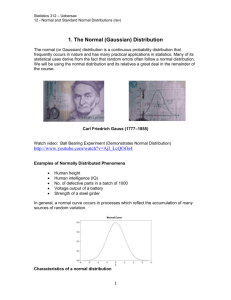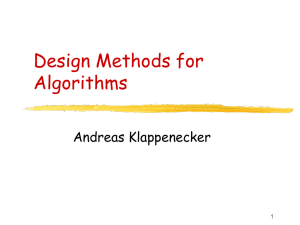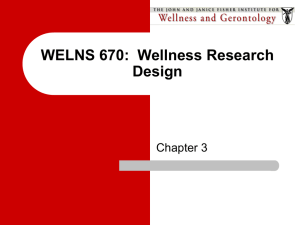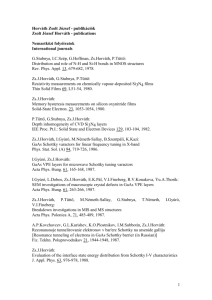ON THE NUMERICAL SOLUTION
advertisement
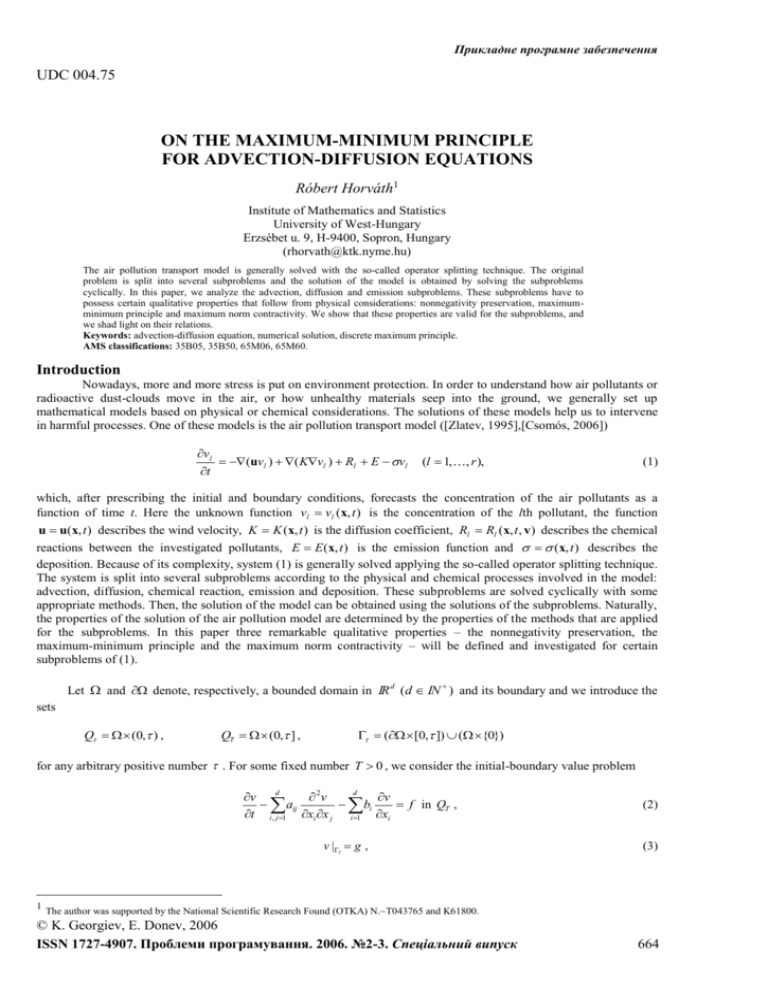
Прикладне програмне забезпечення
UDC 004.75
ON THE MAXIMUM-MINIMUM PRINCIPLE
FOR ADVECTION-DIFFUSION EQUATIONS
Róbert Horváth1
Institute of Mathematics and Statistics
University of West-Hungary
Erzsébet u. 9, H-9400, Sopron, Hungary
(rhorvath@ktk.nyme.hu)
The air pollution transport model is generally solved with the so-called operator splitting technique. The original
problem is split into several subproblems and the solution of the model is obtained by solving the subproblems
cyclically. In this paper, we analyze the advection, diffusion and emission subproblems. These subproblems have to
possess certain qualitative properties that follow from physical considerations: nonnegativity preservation, maximumminimum principle and maximum norm contractivity. We show that these properties are valid for the subproblems, and
we shad light on their relations.
Keywords: advection-diffusion equation, numerical solution, discrete maximum principle.
AMS classifications: 35B05, 35B50, 65M06, 65M60.
Introduction
Nowadays, more and more stress is put on environment protection. In order to understand how air pollutants or
radioactive dust-clouds move in the air, or how unhealthy materials seep into the ground, we generally set up
mathematical models based on physical or chemical considerations. The solutions of these models help us to intervene
in harmful processes. One of these models is the air pollution transport model ([Zlatev, 1995],[Csomós, 2006])
vl
(uvl ) ( Kvl ) Rl E vl
t
(l 1, , r ),
(1)
which, after prescribing the initial and boundary conditions, forecasts the concentration of the air pollutants as a
function of time t. Here the unknown function vl vl (x, t ) is the concentration of the lth pollutant, the function
u u(x, t ) describes the wind velocity, K K (x, t ) is the diffusion coefficient, Rl Rl (x, t , v) describes the chemical
reactions between the investigated pollutants, E E (x, t ) is the emission function and (x, t ) describes the
deposition. Because of its complexity, system (1) is generally solved applying the so-called operator splitting technique.
The system is split into several subproblems according to the physical and chemical processes involved in the model:
advection, diffusion, chemical reaction, emission and deposition. These subproblems are solved cyclically with some
appropriate methods. Then, the solution of the model can be obtained using the solutions of the subproblems. Naturally,
the properties of the solution of the air pollution model are determined by the properties of the methods that are applied
for the subproblems. In this paper three remarkable qualitative properties – the nonnegativity preservation, the
maximum-minimum principle and the maximum norm contractivity – will be defined and investigated for certain
subproblems of (1).
Let and denote, respectively, a bounded domain in IR d (d IN ) and its boundary and we introduce the
sets
Q (0, ) ,
( [0, ]) ( {0})
Q (0, ] ,
for any arbitrary positive number . For some fixed number T 0 , we consider the initial-boundary value problem
v d
2v
aij
t i , j 1 xi x j
v
d
b x
i
i 1
f in QT ,
v |T g ,
1
(2)
i
(3)
The author was supported by the National Scientific Research Found (OTKA) N.~T043765 and K61800.
© K. Georgiev, E. Donev, 2006
ISSN 1727-4907. Проблеми програмування. 2006. №2-3. Спеціальний випуск
664
Прикладне програмне забезпечення
where g : T IR is a given continuous function and f : QT IR is bounded in QT . The linear partial differential
operators in (2) have bounded coefficient functions defined in QT . Moreover, the coefficient functions aij fulfill the
property aij a ji and the inequality
d
a x x
ij i
j
0
i , j 1
is valid for all vectors 0 x IR d . We say that a continuous function v : QT IR solves the problem (2)-(3) if its
derivatives in (2) are bounded, and v satisfies the equality (2) and the condition (3).
Remark 1.1 If ui / xi 0 (i 1, , d ) , then the problem (2)-(3) involves the advection, diffusion and emission
subproblems of system (1). The function v plays the role of the concentration of one of the pollutants. We do not
investigate the chemical reaction subproblem, which are generally described by nonlinear functions, and the deposition
subproblem.
Under the natural assumption that the initial and boundary conditions for the concentration are nonnegative, the
concentration must be nonnegative in any point and at any time instant. This property is called nonnegativity
preservation and it must hold for the solution of the system (2)-(3) too. The nonnegativity preservation property is a
direct corollary of another property: the maximum-minimum principle, which says that – under certain conditions – the
solution of (2)-(3) can be estimated from below and from above by the values of the functions g and f. As a special case,
it follows from Fick's laws that if there is no emission source present in the computational space, then the concentration
takes its maximum and minimum values in the initial state or on the boundary. The maximum norm contractivity
property holds when for arbitrary two initial functions the maximum norm of the difference of the solutions at every
time level is not greater than the maximum norm of the difference of the initial functions.
In paper [Faragó & Horváth, 2006], we considered the problem
v
( K v ) f ,
t
v |T g
and we showed that the validity of the maximum-minimum principle is a sufficient condition of
the maximum norm contractivity and it is equivalent to the nonnegativity preservation property. In this paper, we will
prove the above statement for the more general problem (2)-(3).
For more details regarding maximum principles consult [Protter and Weinberger, 1967]. For Readers who are
interested or involved in scientific computations we remark, that the subproblems of (1) are generally solved
numerically. It is a natural requirement of an adequate numerical method for the air pollution transport model that it has
to possess the discrete equivalents of the qualitative properties listed in the previous paragraph. The discrete maximum
principle is generally guaranteed by some geometrical conditions for the meshes ([Borisov & Sorek, 2004], [Faragó at
al, 2005], [Faragó & Horváth, 2006], [Fujii, 1973]). The conditions of the discrete nonnegativity preservation was
discussed e.g. in [Faragó & Horváth, 2001]. The discrete maximum norm contractivity was analyzed for onedimensional parabolic problems in [Horváth, 1999] and in [Kraaijevanger, 1992].
1 Maximum-Minimum Principle and the Nonnegativity Preservation
In this section, we will define the maximum-minimum principle and the nonnegativity preservation property
and we show their validity for the problem (2)-(3). We show the equivalence of the two properties.
DEFINITION 2.1. We say that the problem (2)-(3) satisfies the maximum-minimum principle if for any fixed functions g
and f the solution v satisfies the inequality
min g t1 min 0, inf f v(x, t1 ) max g t1 max 0, sup f
Q
Q
t1
t1
t1
t1
for all x , 0 t1 T .
The maximum-minimum principle guarantees the uniqueness of the solution of problem (2)-(3). We consider the
function v v v with two different solutions v and v . The function v is a solution of the problem (2)-(3) with
the choice f=0 and g=0. Thus, based on the maximum-minimum principle we have v (x, t1 ) 0 for all x and
t1 (0, T ) . This implies the uniqueness of the solution.
665
Прикладне програмне забезпечення
DEFINITION 2.2. The problem (2)-(3) is called nonnegativity preserving if for any fixed functions g and f with g |t 0
1
and f |Q 0 (0 t1 T ) the solution v is nonnegative in Qt1 .
t1
Theorem 2.3 The problem (2)-(3) satisfies the maximum-minimum principle if and only if it preserves the
nonnegativity.
PROOF. The necessity of the condition is trivial. To show the sufficiency, let us fix the functions g and f. Then, we
define the function
v v min g t min{ 0, inf f }
t1
Qt1
with the solution v. Clearly, v is a solution of the problem
d
v
2v
aij
t i , j 1 xi x j
v
d
b x
i
i 1
f min{ 0, inf f },
Qt1
i
v | g min g t min{ 0, inf f } .
t1
T
Qt1
Naturally,
( f min{ 0, inf f }) |Q 0
t1
Qt1
and
( g min g t min{ 0, inf f }) | 0 ,
t1
t1
Qt1
and these relations imply that v is nonnegative on Qt by virtue of the nonnegativity preservation assumption. Thus the
1
lower estimation
min g t1 min 0, inf f v(x, t1 )
Q
t1
t1
is satisfied. By choosing
v max g v t max{ 0, sup f } ,
t1
Qt1
the upper bound is proved similarly. This completes the proof.
Theorem 2.4 Let g and f be two fixed functions. Then, the solution v of the problem (2)-(3) satisfies the inequality
1
sup e t1 min min ge t , inf fe t
t1
Qt1
0
1
v(x, t ) inf e t max max get , sup fe t
0
Q
1
t1
(4)
t1
for any t1 (0, T ) and x .
PROOF. For any arbitrary number 0 we define the function vˆ(x, t ) v(x, t )e t . It can be seen easily that v̂ is a
solution of the problem
vˆ d
2 vˆ
aij
t i , j 1 xi x j
666
vˆ
d
b x
i
i 1
i
vˆe t f ,
(5)
Прикладне програмне забезпечення
vˆ |T ge t .
As v̂ is continuous on Qt , it takes its maximum either on the boundary t or in Qt at some point (x 0 , t 0 ) . In the first
case we trivially have
1
1
1
sup vˆ max ge t .
(6)
t1
Qt1
In the second case, the relations
sup vˆ vˆ(x 0 , t 0 ) ,
Qt1
vˆ 0 0
vˆ 0 0
(x , t ) 0 (i 1,, d ) ,
(x , t ) 0 ,
xi
t
d
a (x , t
0
ij
i , j 1
0
)
2 vˆ
(x 0 , t 0 ) 0
xi x j
hold. The last two relations and equation (5) imply that
f (x 0 , t 0 ) vˆ(x 0 , t 0 )e t 0 ,
0
that is
f (x 0 , t 0 )e t
fe t
.
vˆ(x , t )
sup
Qt1
0
0
0
(7)
Thus, in general case, using the upper bounds (6) and (7) we obtain the estimation
fe t
vˆ(x, t1 ) supvˆ max max get , sup
.
Q
Q
t1
t1
t1
Multiplying both sides by e t1 and taking into account that the relation is true for all positive numbers 0 , we obtain
the inequality on the right-hand side of (4). The lower bound can be proved similarly.
Theorem 2.5. The problem (2)-(3) satisfies the maximum-minimum principle and the nonnegativity preservation
property.
PROOF. Because of Theorem 2.3, it is enough to show that the problem (2)-(3) preserves the nonnegativity. Let
t1 (0, T ) be an arbitrary number and f and g two fixed functions with the properties f |Qt 0 and g |t 0 . Then, for
1
1
any t 0 (0, t1 ] , we have f |Qt 0 and g |t 0 , which result in 0 v(x, t0 ) in view of (4). That is v is nonnegative in
0
0
Qt1 .
2. Maximum Norm Contractivity
In this section, we define the maximum norm contractivity property and prove that the problem (2)-(3)
possesses this property.
DEFINITION 3.1. The problem (2)-(3) is called contractive in maximum norm when for all arbitrary three functions f,
g g and g g with the property ( g g ) |[ 0,t1 ] 0 (0 t1 T ) the solutions v and v of the problem (2)-(3)
satisfy the relation
max | v (x, t1 ) v (x, t1 ) | max | g (x,0) g (x,0) | .
x
x
Theorem 3.2 The problem (2)-(3) is contractive in maximum norm.
PROOF. Let f, g g and g g be three arbitrary functions with the property ( g g ) |[ 0,t1 ] 0 . Let v and v
the solutions of the problem (2)-(3). We consider the functions v v v with max | g (x,0) g (x,0) | .
x
These functions solve the problem
667
Прикладне програмне забезпечення
d
v
2 v
aij
t i , j 1 xi x j
d
b
i
i 1
v
0,
xi
(5)
(v ) |T ( g g ).
It is easy to see that ( ( g g )) | 0 . Due to Theorem 2.5, the problem (2)-(3) preserves the
t1
nonnegativity. That is, v v v is nonnegative in Qt , thus we have
1
max | v (x, t1 ) v (x, t1 ) | max | g (x,0) g (x,0) | .
x
x
This completes the proof.
1.
2.
[Borisov & Sorek, 2004] V. S. Borisov, S. Sorek, On the Monotonicity of Difference Schemes for Computational Physics, SIAM J. Sci.
Comput. 25 (2004), 1557—1584.
[Csomós, 2006] P. Csomós, Analysis of a Transport Model Applying Operator Splitting and Semi-Lagrangian Method, Int. J. Comp. Sci. Eng.,
to appear.
[Faragó & Horváth, 2001] I. Faragó, R. Horváth, On the Nonnegativity Conservation of Finite Element Solutions of Parabolic Problems. Proc.
Conf. Finite Element Methods: Three-Dimensional Problems, eds. P. Neittaanmäki, M. Krizek, GAKUTO Internat. Series Math. Sci. Appl., 15,
Gakkotosho, Tokyo, 2001, 76—84.
[Faragó at al, 2005] I. Faragó, R. Horváth, S. Korotov, Discrete Maximum Principle for Linear Parabolic Problems Solved on Hybrid Meshes,
Appl. Num. Math. 53 (2005), 249—264.
[Faragó & Horváth, 2006] I. Faragó, R. Horváth, Discrete Maximum Principle and Adequate Discretizations of Linear Parabolic Problems,
SIAM Sci. Comp., to appear.
[Fujii, 1973] H. Fujii, Some Remarks on Finite Element Analysis of Time-Dependent Field Problems, Theory and Practice in Finite element
Structural Analysis, Univ. Tokyo Press, Tokyo (1973) 91—106.
[Horváth, 1999] R. Horváth, Maximum Norm Contractivity in the Numerical Solution of the One-Dimensional Heat Equation, Appl. Num.
Math. 31 (1999), 451—462.
[Kraaijevanger, 1992] J.F.B.M. Kraaijevanger, Maximum Norm Contractivity of Discretization Schemes for the Heat Equation, Appl. Num.
Math. 9 (1992), 475-492.
[Zlatev, 1995] Z. Zlatev, Computer Treatment of Large Scale Air Pollution Models, Kluwer Academic Publishers, Dordrecht 1995.
3.
4.
5.
6.
7.
8.
9.
10. [Protter & Weinberger, 1967] M. H. Protter, H. F. Weinberger, Maximum Principles in Differential Equations, Prentice-Hall, Inc., Englewood
Cliffs, N. J., 1967.J. Sci. Comp., 20, PP. 1456 – 1480
668



